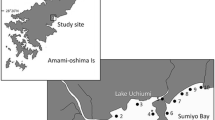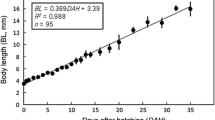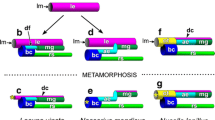Abstract
Females of the spionid polychaete Streblospio benedicti (Webster) produce either small eggs (60–70 μm diameter) and planktotrophic larvae, or large eggs (100–200 μm) and lecithotrophic larvae that reportedly do not feed. This intraspecific polymorphism, a form of poecilogony, is potentially useful in studies of larval ecology and evolution, but necessary data on larval form and function are lacking. This study describes the morphology and nutritional biology of larvae obtained from Atlantic (South Carolina) and Pacific (California and Washington) populations from 2003 to 2005. The two types of larvae produced by Atlantic S. benedicti differed greatly in length (229±22 μm SD for planktotrophs vs. 638±40 μm for lecithotrophs) and chaetiger number (2–5 vs. 10–11) at release from the female’s brood pouch. Planktotrophic larvae bore long provisional chaetae on their first chaetiger; provisional chaetae were absent in lecithotrophic larvae. Larvae from Pacific populations were all of the lecithotrophic form, and were similar to their Atlantic counterparts in all respects. High-speed video microscopy revealed that both types of larvae used opposed bands of cilia to capture suspended particles and transport them to the mouth, where they were often ingested. Lecithotrophic larvae reared with suspended phytoplankton (Rhodomonas sp., 104 cells ml−1) for 2 days grew significantly faster than sibling larvae reared without added food, indicating that these larvae can digest and assimilate ingested food. Larvae of S. benedicti that develop from large eggs are thus facultative planktotrophs instead of obligately non-feeding lecithotrophs, a result that affects the interpretation of comparative studies of the ecology and evolution of larvae in S. benedicti and certain other marine invertebrates.




Similar content being viewed by others
References
Allen J, Podolsky RD (2006) Uncommon diversity in developmental mode and larval form in Macrophiothrix (Echinodermata: Ophiuroidea). Mar Biol (in press)
Blake JA, Arnofsky PL (1999) Reproduction and larval development of the spioniform polychaeta with application to systematics and phylogeny. In: Dorresteijn AWC, Westheide W (eds) Reproductive strategies and developmental patterns in Annelids. Hydrobiologia 402:57–106
Botello G, Krug, PJ (2006) Desperate larvae revisited: age, energy and experience affect sensitivity to settlement cues in larvae of the gastropod Alderia sp. Mar Ecol Prog Ser (in press)
Bouchet P (1989) A review of poecilogony in gastropods. J Molluscan Stud 55:67–78
Bridges TS (1993) Reproductive investment in four developmental morphs of Streblospio. Biol Bull 184:144–152
Carlton JT (1979) History, biogeography and ecology of the introduced marine and estuarine invertebrates of the Pacific Coast of North America. Dissertation, University of Califonia, Davis
Chia F-S, Gibson G, Qian P-Y (1996) Poecilogony as a reproductive strategy of marine invertebrates. Oceanol Acta 19:203–208
Dean D (1965) On the reproduction and larval development of Streblospio benedicti Webster. Biol Bull 128:67–76
Emlet RB (1986) Facultative planktotrophy in the tropical echinoid Clypeaster rosaceous and a comparison with obligate planktotrophy in Clypeaster subdepressus. J Exp Mar Biol Ecol 95:183–202
Gibson GD, Smith HL (2004) From embryos to juveniles: morphogenesis in the spionid Boccardia proboscidea (Polychaeta). Invert Biol 123:136–145
Hart MW (1996) Evolutionary loss of larval feeding: development, form and function in a facultatively feeding larva, Brisaster latifrons. Evolution 50:174–187
Hart MW (2000) Phylogenetic analyses of mode of larval development. Sem Cell Dev Biol 11:411–418
Havenhand JN (1995) Evolutionary ecology of larval types. In: McEdward LR (ed) Ecology of marine invertebrate larvae. CRC Press, Boca Raton, pp 79–122
Hoagland E, Robertson R (1988) An assessment of poecilogony in marine invertebrates: phenomenom or fantasy? Biol Bull 174:109–124
Jaeckle WB (1995) Variation in the size, energy content and biochemical composition of invertebrate eggs: correlates to the mode of larval development. In: McEdward LR (ed) Ecology of marine invertebrate larvae. CRC Press, Boca Raton, pp 49–77
Kempf SC, Hadfield MG (1985) Planktotrophy by the lecithotrophic larvae of a nudibranch, Phestilla sibogae. Biol Bull 169:119–130
Kempf SC, Todd CD (1989) Feeding potential in the lecithotrophic larvae of Adalaria proxima and Tritonia hombergi: an evolutionary perspective. J Mar Biol Assoc UK 69:659–682
Krug PJ (1998) Poecilogony in an estuarine opistobranch: planktotrophy, lecithotrophy and mixed clutches in a population of the ascoglossan Alderia modesta. Mar Biol 132:483–494
Levin LA (1984) Multiple patterns of development in Streblospio benedicti from three coasts of North America. Biol Bull 166:494–508
Levin LA, Creed EL (1986) Effect of temperature and food availability on reproductive responses of Streblospio benedicti with planktotrophic or lecithotrophic development. Mar Biol 92:103–113
Levin LA, Caswell H, DePatra KD, Creed EL (1987) Demographic conseqeunces of larval development mode: planktotrophy vs. lecithotrophy in Streblospio benedicti. Ecology 68:1877–1886
Levin LA, Huggett DV (1990) Implications of alternative reproductive modes for seasonality and demography in an estuarine polychaete. Ecology 71:2191–2208
Levin LA, Zhu J, Creed EL (1991) The genetic basis of life-history characters in a polychaete exhibiting planktotrophy and lecithotrophy. Evolution 45:380–397
Levin LA, Bridges TS (1994) Control and consequences of alternative developmental modes in a poecilogonous polychaete. Am Zool 34:323–332
Levin LA, Bridges TS (1995) Pattern and diversity in reproduction and development. In: McEdward LR (ed) Ecology of marine invertebrate larvae. CRC, Boca Raton, pp 1–48
Manahan DT (1990) Adaptations by invertebrate larvae for nutrient acquisition from seawater. Am Zool 30:147–160
Marsh AG, Fielman KT (2005) Transcriptome profiling of individual larvae of two different developmental modes in the poecilogonous polychaete Streblospio benedicti. J Exp Zool (Mol Dev Evol) 304B:238–249
Martin D, Pinedo S, Sarda R (1996) Grazing by meroplanktonic polychaete larvae may help to control nanoplankton in the NW Mediterranean littoral: in situ experimental evidence. Mar Ecol Prog Ser 143:239–246
McEdward LR (2000) Adaptive evolution of larvae and life cycles. Sem Cell Dev Biol 11:403–409
McHugh D, Rouse GW (1998) Life history evolution of marine invertebrates: new views from phylogenetic systematics. Trends Ecol Evol 13:182–186
Miner B, Sanford E, Strathmann RR, Pernet B, Emlet R (1999) Functional and evolutionary implications of opposed bands, big mouths, and extensive oral ciliation in larval opheliids and echiurids. Biol Bull 197:14–25
Pernet B (2003) Persistent ancestral feeding structures in non-feeding annelid larvae. Biol Bull 205:295–307
Pernet B, Schroeder PC (1999) Opposed ciliary bands and larval feeding in a capitellid annelid. Am Zool 39A:226
Pernet B, Qian P-Y, Rouse GW, Young CM, Eckelbarger KJ (2002) Phylum Annelida: polychaeta. In: Young CM (ed) Atlas of marine invertebrate larvae. Academic, London, pp 209–243
Perron FE (1981) Larval growth and metamorphosis of Conus in Hawaii. Pac Sci 35:25–38
Rouse GW (1999) Trochophore concepts: ciliary bands and the evolution of larvae in spiralian metazoa. Biol J Linn Soc 66:411–464
Rouse GW (2000a) Bias? What bias? The evolution of downstream larval-feeding in animals. Zool Scr 29:213–236
Rouse GW (2000b) The epitome of hand waving? Larval feeding and hypotheses of metazoan phylogeny. Evol Dev 2:222–233
Schulze SR, Rice SA, Simon JL, Karl SA (2000) Evolution of poecilogony and the biogeography of North American populations of the polychaete Streblospio. Evolution 54:1247–1259
Strathmann MF (1987) Reproduction and development of marine invertebrates of the Northern Pacific coast. University of Washington Press, Seattle
Strathmann RR, Jahn TL, Fonseca JRC (1972) Suspension feeding by marine invertebrate larvae: clearance of particles by ciliated bands of a rotifer, pluteus and trochophore. Biol Bull 142:505–518
Strathmann RR, Eernisse DJ (1994) What molecular phylogenies tell us about the evolution of larval forms. Am Zool 34:502–512
Wray GA (1996) Parallel evolution of non-feeding larvae in echinoids. Syst Biol 45:308–322
Wray GA, Raff RA (1991) The evolution of developmental strategy in marine invertebrates. Trends Ecol Evol 6:45–50
Yokouchi K (1991) Seasonal distribution and food habits of planktonic larvae of benthic polychaetes in Volcano Bay, Southern Hokkaido, Japan. Ophelia Suppl 5:401–410
Acknowledgements
We thank D. Allen, R. Brodie, J. Cowart, P. Kenny and S. Woodin for facilitating work at the Baruch Marine Field Laboratory (BMFL); S. Woodin also generously provided space and equipment in Columbia, SC. Likewise, we thank the director and staff of the Friday Harbor Laboratories (FHL) for providing space, equipment and support. R. Rogers (Department of Fish and Game, WA) helped us obtain import permits, and FHL staff helped us meet their provisions. D. Bulthuis permitted us to collect worms in the Padilla Bay National Estuarine Research Reserve. R. Strathmann kindly allowed us to use his high-speed video camera. Discussions with J. Blake, L. Levin, R. Podolsky and R. Strathmann were helpful in clarifying some of our ideas, and P. Krug and two anonymous reviewers made valuable comments on the manuscript. This work was supported in part by a Visiting Scientist Award to BP from the BMFL. Contribution 1427 from the Belle W. Baruch Institute for Marine and Coastal Sciences, University of South Carolina.
Author information
Authors and Affiliations
Corresponding author
Additional information
Communicated by J.P. Grassle, New Brunswick
Rights and permissions
About this article
Cite this article
Pernet, B., McArthur, L. Feeding by larvae of two different developmental modes in Streblospio benedicti (Polychaeta: Spionidae). Mar Biol 149, 803–811 (2006). https://doi.org/10.1007/s00227-006-0266-8
Received:
Accepted:
Published:
Issue Date:
DOI: https://doi.org/10.1007/s00227-006-0266-8




